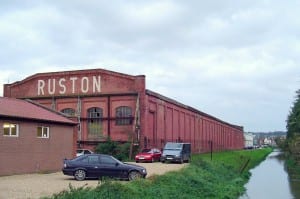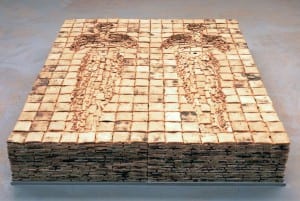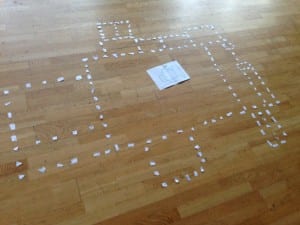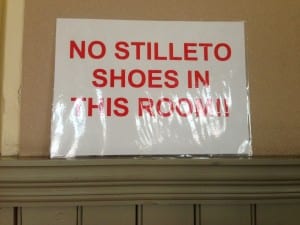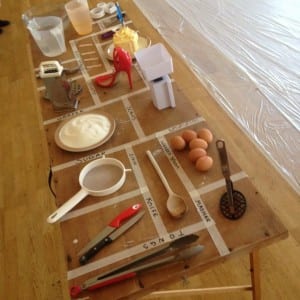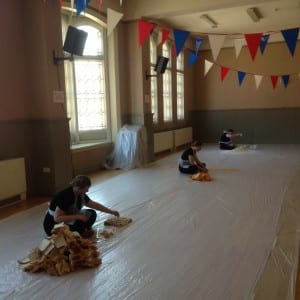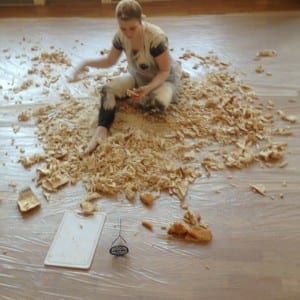Site Specific Performance final Blog post
Zara Cain
The history of our piece
In the 1850’s there was a famous factory called the Ruston’s factory which is now known as Siemens. This organization was run by an industrial manufacturer called Joseph Ruston. The company was known for the manufacture of narrow and standard gauge, locomotives and steam shovels. They became Ruston Practor and Company in 1857 when Joseph Ruston joined them. From 1866 they built a number of six coupled tank locomotives one of which was sent to the Paris exhibition in 1867.
Whilst the Ruston’s factory was making a profit in 1890 Joseph Ruston decided to build the Lincoln Drill Hall. £10.000 was spent to build the hall, primarily for use by the military and the police but also to ensure that it was accessible to Ruston’s employees and the general public.
The factory workers at the Ruston’s factory wanted a pay rise whilst the Drill Hall was being built, but Ruston refused this stating “Don’t deprive me of my bread and cheese.” From then on the Drill hall to the workers was known mockingly as the “Bread and Cheese Hall”.
Rustons Factory from Riverside Path at al (2014)
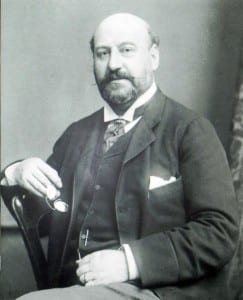
Joseph Ruston (1835-19897) from Graces guide to industrialisation at al (2016)
Our influences
Site Specific performance focuses primarily on place and the history behind that place, but there are many fragments to Site Specific performance. Mike Pearson in his article Performance and Archaeology displays that “Performance and archaeology favour body, object, place, activity and context” (Pearson, 2001). With our piece we wanted to create theatre that uses senses, objects and the body; using these will assist in building the narrative.
From the beginning our group was interested in using senses. Janet Cardiff’s piece ‘The forty part motet’ creates a sound-scape using speakers.
Forty separately recorded voices are played back through forty speakers strategically placed throughout the space. The sounds that the audience can here are from a 40-part choral performance of English composer Thomas Tallis’s 16th century composition sung by the Salisbury Cathedral Choir.
From the picture below one can note that this creates an emotional evocative sound sculpture that would feel intimate even with in a public space. These emotions are felt through the sense of hearing. We decided to use some of Janet Cardiff’s ideas of senses in our piece.
40 part motet from Julia Fryett at al (2013)
We were also influenced by Bobby Baker with her use of natural resources in her piece ‘Mad gyms and kitchens’. This piece demonstrates how Bobby Baker achieves the ultimate ‘well-being factor’. Throughout the piece Bobby will use vegetables and different types of foods and throw them at walls letting all of her anger out.
On researching this it was interesting to see how the actor can use food in different ways. The use of food can enhance a piece by picking up on the audiences senses; by doing this the audience can feel certain emotions for the piece by relating the senses to the memories they have of the food, to the piece of theatre they are watching, listening and smelling. Lynne Gardner from the Guardian states ‘Like all of Bakers work you leave feeling better than when you came in. It’s not a show but a priceless gift wrapped in theatrical box of tricks’ (Guardian, 2004)
Mad gyms and kitchens from Daily life ltd at al (2011)
Our main stimulus evolved from the art sculpture ‘Bread’ which was produced by the contemporary artist Anthony Gormley. In 1980 Anthony Gormley produced a piece of art that used bread and his body as his main material.
He sourced 8,000 loafs of bread and stored them round his four floored London home in Peckham. He worked alongside the Artist Vicken Parsons and she talks about her time spent with Anthony on this project. “Once the bread was dry (and some of it mouldy), we waxed it. We got huge slabs of wax that we smashed into pieces and melted on a camping stove. Each piece was dipped and squashed between boards; the wax couldn’t be too hot or it would turn in to toast. I didn’t have any part in the eating. That was Anthony’s job. I drew around Anthony, then he drew within that to get the 3D form, and we worked from this as we built the piece.” (Guardian, 2012)
Bread Works, 1979-1982 from Anthony Gormley at al (2012)
Anthony Gormley in his YouTube channel ‘Taste’ states ‘that bread seems to express something about our relationship with the material world; it is the industrialization of the very stuff of life, the thing on which we depend.’ (Gormley, 2015) It was interesting listening to Gormley talk about bread as a material, a product and not a food. I was inspired by his idea of looking into bread and its industrialization. It makes me want to explore the juxtaposition between nature (flour, food, water and yeast) and its industrialization (factory, bleach, process) and the journey between them.
(Tate, 2015)
Our process
The Handbook on drifting (Extracts) which was given to us by Michele at the beginning of this course was of great assistance. One of the points that I felt was most beneficial was “avoid ending your ‘drifts’ in the pub or sinking slowly back into the everyday.” (Extracts, 2006) Site specific performance I believe is at its best when it explores and discovers stories that are unknown to the general public. Whilst drifting throughout the Drill Hall and around the streets of Lincoln I tried my best to go to areas that I had never visited before, doing this I noticed small things that usually I would not. ‘Going back to the everyday’ for me would be putting my earphones on and walking around not noticing the people, their interactions, the buildings, the weather or the world around me. It is important that whilst drifting you open up your mind to new experiences and ideas and this for me was a positive way to start sourcing ideas.
At the beginning of our process our group sourced a bird’s eye planned view of the Drill Hall. Our main aim was to build a three dimensional version of the Drill Hall, but through practice with other resources such as paper and blocks we found this unsuccessful. Looking at the floor plan of the Drill Hall we came to a decision that not only would it be easier building it in this way but we could also use the bread in an interesting way. Using whole pieces would be difficult so we experimented by using paper.
In the example bellow we cut up the paper into small rectangles and we created a miniature version of the Drill Hall. By actually physically getting up and creating it we found it easier to recognize what worked and what did not work. We knew that cutting the bread up had a positive effect on our piece and we realized that the bread could represent bread soldiers that we have with a dippy egg. Knowing that the Drill Hall used to be a training unit for soldiers in World War 1, it seemed only right to incorporate this into our work.
Birds eye plan, Drill Hall from Zara, Chloe and Alice at al (2016)
4,000 men served at the Lincoln Unit in World War 1 we knew that we would have to create 4,000 bread soldiers. We calculated that we would need to collect 57 loafs of bread to create this piece and on top of that sourcing the cheese and flour to go with it.
James R. Hamilton in his book the Art of Theatre states that “If theatrical performances are to be regarded as the products of a practice of art making, performances must be observable, appreciable and evaluable as achievements.” (Hamilton, J.R. 2007) Understanding and using Hamilton’s theory we decided to create a video that would explain what our piece was focusing on. Hopefully the audience will then observe this and it will highlight the achievements we have made.
The short film shows images and videos of the process of bread making. Our group visited the windmill and used these images in our overall performance. Hamilton states that “An interest in achievements in works of art involves an interest in details, an interest in answering questions, why this detail is present and not that one and what this detail can tell us about the whole work.” (Hamilton, J.R. 2007) After reading this article I began to understand how important detail is in site specific and in performance in general. To make the piece successful as a performance we would need to make the story clear and detailed.
We recorded the videos and images on a sunny, bright, and still day. We understand that weather can change the perceptions of a performance instantly, our group believe that our piece is happy and uplifting and so doing it on a wet and windy day would have caused a mismatch in the piece that may have led to some confusion for the audience. We focused on details when filming our video, taking into account the angles we filmed at. When filming the windmill I recorded it slowly showing all of its angles; I felt that this created a calm and relaxed atmosphere and it starts to tell the story and represents the journey of bread.
(VIDOOO15, 2016)
We also recorded a short video of the kneading of bread as this was important as part of breads journey and also the journey of our performance. We used a wooden chopping board as opposed to a modern plastic one as we wanted to express the era of the late 1800’s. When filming we needed to make sure that all of the resources and props were ones that would have been used at the time, otherwise an inaccurate prop would distracted from the meaning of the piece. The final video will be playing throughout our performance on a loop; this video will be playing whilst we create the miniature version of the Drill Hall.
(Needing of Dough University Project, 2016)
The piece will be performed in the ‘Phill Cosker Sweet.’ We chose this room as it had bunting in it which suggested a ‘Great British bake off vibe’ which in a sense provided a link between the current and the historic. Given that the main idea in our piece is bread making, we feel that the link between the bread and the bunting suggests a subtle/unconscious connection in the audience that will be both uplifting and inspiring.
When we pitched our ideas to Conon he suggested that our ideas were too literal and so we looked to change some aspects of the piece. Initially, I found Conran’s critique difficult to deal with. However, in performance, it is important to accept that initial ideas need to change and develop and I have tried to recognize that writing, planning and rehearsing site specific performance is an ongoing process and one should not become too attached to an idea early on in this process.
When we initially explained our ideas to Conon he was positive about the idea of expressing the industrialization of bread, cheese and flour and how we could portray this in our piece in a unique and artistic way. Performance and Place by Lesly Hill and Helen Paris introduces the idea that ‘Live art is one of the most vibrant and influential of creative approaches in the United Kingdom: A research engine driven by artists who are working forms, contexts and spaces to open up new artist models, new languages for the reputation of ideas, new ways of activating audiences and new strategies.” (Hill, Paris, 2006) In a sense live art needs to be vibrant to be meaningful to the audience and by using the space around us effectively we hope to make the piece less literal and more creative.
Our group will incorporate Janet Cardiff’s influence of the ’forty part motet’ which I explained in more detail in my influences. We will place three separate speakers in each corner of the room and through the speakers we will play factory noises, to create “an installation of industrialization”. Whilst the sounds are being played the actors will be placed in the middle of the room with a station of bread, cheese or flour; we will be wearing black dresses, hair nets and aprons and we will be moving our materials from one side of to the other for one hour.
(Factory Noise, 2016)
There will be a table placed in front of the three stations; the table will hold a number of different kitchen utensils such as an egg timer, cheese grater, scales and foods such as eggs. In the middle of the table there will be a red stiletto which we will incorporate as the room where we will be performing used to be a room for dance classes and on the door as you walk in there is a sign that states “No stilettos shoes in this room.” This will create an interesting juxtaposition between industrial production and leisure for the audience.
No Stiletto Shoes in this Room from Zara, Chloe, Alice at al (2016) IMG_4366.JPG from Michael Pinchbeck at al (2016)
During the performance, each actor will go up to the table and incorporate a kitchen utensil into our piece. For example I may decide to pick up the scales and weigh the bread before I cut it and place it into a pile. This is a symbolic representation of the industrialization of bread, showing how bleach is added to the bread to turn it white and questioning other production techniques in the making of bread that we may not know about.
IMG_4367.JPG from Michael Pinchbeck at al (2016)
In the last hour we want to create chaos and for the audience to feel the intensity in the room. In this hour we will use and take anything that we want to and add it to our materials. We are also allowed to use each other’s materials. In this hour we experiment and create different textures with the foods and use them on parts of our bodies. For example, I mixed bread, cheese and water and turned it into a thick paste and used it on my face like a beauty cream. In this hour we use our bodies as the materials as well, making footprints with the flour and so forth.
In the “chaos hour” we want to suggest the suppressed anarchy (and anomie) that can lie beneath the surface of regimented industrialization and the workers whose lives were (and are) governed by clocking on and clocking off.
IMG_4375.JPG from Michael Pinchbeck at al (2016) IMG_4764.JPG from Zara Cain at al (2016)
Evaluation
The main aim of our piece was to display and express the industrialisation of the basic staple of our diet, bread; not only to show how it is made, but also to understand who makes it. Because Site Specific is a performance specific to the site it was vital to make the link between the sites history and our performance. We did this by incorporating written text into the performance which was accessible to the audience as they came through the door. The text gave a brief history behind the piece and what we were attempting to achieve by the performance.
When we spoke to the audience after the performance, they gave positive feedback about this aspect advising us that it had increased their understanding of the performance and the history that lay behind it.
I believe that it would have been helpful for the group to practice with our materials more, but this proved difficult due to the cost of them. We could have used other dummy materials and practised for the full 3 hours rather than the 30 minutes we originally did when rehearsing.
A major issue that we faced was in the performance and structure of the last ‘chaos hour’. In rehearsals we had only performed it for approximately ten minutes and so we had little understanding as to how much physical and mental energy this scene would need from each of us.
In the performance I feel that we started the “chaos hour” too early which meant that after 20 minutes all of our extra props such as the eggs, water and sugar had been used up and I feel that we then struggled as to how to take the performance to the next level and so the end of the performance was something of an anti-climax.
If I was to perform this site specific performance again I would make sure that we rehearsed exactly as we intended to perform in the “chaos hour” to ensure that even though it was “chaos” it was structured chaos which would have led to the audience experiencing a more fulfilling finale.
Bibliography
Books
1. Hamliton, J.R (2007) Art of Theatre. Landscape and environment: Arts and Humanities Research Council.
2. Paris, H. Hill, P. (2006) Performance and place. London: January 1.
Audio recordings
1. Factory Noise. ( 2016) The factory noise [Audio Recording] Youtube.
Video
1. Needing of Dough University Project from Zara, Chloe and Alice at al (2016) Available from
2. VIDOOO15 from Zara, Chloe and Alice at al (2016) Available from
3. Tate (2015) Anthoney Gormley Breaking Bread. 11 October. London. Available from
Newspaper articles
1. Gardner, L. (2004) Bobby Baker Mad Gyms and Kitchens. The Guardian, 2 March 2004.
2. Parsons, V. (2012) Anthony Gormley Baking Bread. The Guardian, 3 May 2013
Journal articles
1. Pearson, M. (2001) Performance and Archaeology. Performance in Archaeology, 55-58.
Photographs
1. Joseph Ruston (1835-19897) from Graces guide to industrialisation at al (2016)
2. Rustons Factory from Riverside Path at al (2014)
3. 40 part motet from Julia Fryett at al (2013)
4. Mad gyms and kitchens from Daily life ltd at al (2011)
5. Bread Works, 1979-1982 from Anthony Gormley at al (2012)
6. Birds eye plan, Drill Hall from Zara, Chloe and Alice at al (2016)
7. No Stiletto Shoes in this Room from Zara, Chloe, Alice at al (2016)
8. IMG_4366.JPG from Michael Pinchbeck at al (2016)
9. IMG_4367.JPG from Michael Pinchbeck at al (2016)
10. IMG_4375.JPG from Michael Pinchbeck at al (2016)
11. IMG_4764.JPG from Zara Cain at al (2016)
